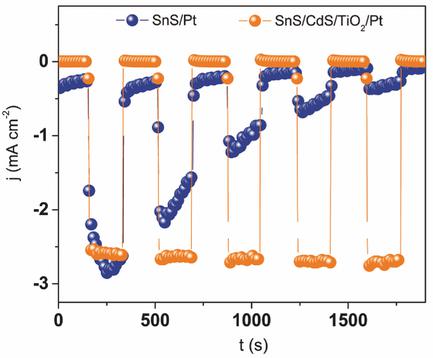Our official English website, www.x-mol.net, welcomes your
feedback! (Note: you will need to create a separate account there.)
Earth‐Abundant Tin Sulfide‐Based Photocathodes for Solar Hydrogen Production
Advanced Science ( IF 14.3 ) Pub Date : 2017-10-16 , DOI: 10.1002/advs.201700362 Wei Cheng 1 , Nirala Singh 2 , Will Elliott 3 , Joun Lee 1 , Alan Rassoolkhani 1 , Xuejun Jin 4 , Eric W. McFarland 2 , Syed Mubeen 1
Advanced Science ( IF 14.3 ) Pub Date : 2017-10-16 , DOI: 10.1002/advs.201700362 Wei Cheng 1 , Nirala Singh 2 , Will Elliott 3 , Joun Lee 1 , Alan Rassoolkhani 1 , Xuejun Jin 4 , Eric W. McFarland 2 , Syed Mubeen 1
Affiliation

|
Tin‐based chalcogenide semiconductors, though attractive materials for photovoltaics, have to date exhibited poor performance and stability for photoelectrochemical applications. Here, a novel strategy is reported to improve performance and stability of tin monosulfide (SnS) nanoplatelet thin films for H2 production in acidic media without any use of sacrificial reagent. P‐type SnS nanoplatelet films are coated with the n‐CdS buffer layer and the TiO2 passivation layer to form type II heterojunction photocathodes. These photocathodes with subsequent deposition of Pt nanoparticles generate a photovoltage of 300 mV and a photocurrent density of 2.4 mA cm−2 at 0 V versus reversible hydrogen electrode (RHE) for water splitting under simulated visible‐light illumination (λ > 500 nm, Pin = 80 mW cm−2). The incident photon‐to‐current efficiency at 0 V versus RHE for H2 production reach a maximum of 12.7% at 575 nm with internal quantum efficiency of 13.8%. The faradaic efficiency for hydrogen evolution remains close to unity after 6000 s of illumination, confirming the robustness of the heterojunction for solar H2 production.
中文翻译:

富含地球的硫化锡基光电阴极,用于生产太阳能氢
锡基硫族化物半导体尽管是光伏的诱人材料,但迄今为止在光电化学应用中仍表现出较差的性能和稳定性。在此,据报道,一种新颖的策略可提高在不使用牺牲试剂的情况下在酸性介质中生产H 2的单硫化锡(SnS)纳米血小板薄膜的性能和稳定性。P型SnS纳米血小板膜涂有n- CdS缓冲层和TiO 2钝化层,形成II型异质结光电阴极。这些光阴极以及随后沉积的Pt纳米颗粒产生300 mV的光电压和2.4 mA cm -2的光电流密度在0 V下与可逆氢电极(RHE)在模拟可见光照明下(λ> 500 nm,P in = 80 mW cm -2)进行水分解。相对于RHE,H 2产生在0 V时的入射光子电流效率在575 nm处达到12.7%的最大值,内部量子效率为13.8%。照射6000 s后,析氢的法拉第效率仍然接近于1,这证实了异质结对太阳能H 2产生的鲁棒性。
更新日期:2017-10-16
中文翻译:

富含地球的硫化锡基光电阴极,用于生产太阳能氢
锡基硫族化物半导体尽管是光伏的诱人材料,但迄今为止在光电化学应用中仍表现出较差的性能和稳定性。在此,据报道,一种新颖的策略可提高在不使用牺牲试剂的情况下在酸性介质中生产H 2的单硫化锡(SnS)纳米血小板薄膜的性能和稳定性。P型SnS纳米血小板膜涂有n- CdS缓冲层和TiO 2钝化层,形成II型异质结光电阴极。这些光阴极以及随后沉积的Pt纳米颗粒产生300 mV的光电压和2.4 mA cm -2的光电流密度在0 V下与可逆氢电极(RHE)在模拟可见光照明下(λ> 500 nm,P in = 80 mW cm -2)进行水分解。相对于RHE,H 2产生在0 V时的入射光子电流效率在575 nm处达到12.7%的最大值,内部量子效率为13.8%。照射6000 s后,析氢的法拉第效率仍然接近于1,这证实了异质结对太阳能H 2产生的鲁棒性。











































 京公网安备 11010802027423号
京公网安备 11010802027423号